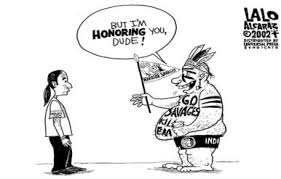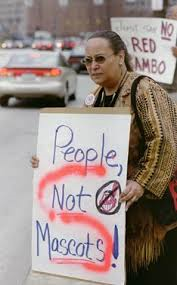Dr. Wood
North American Indians Sec A
August 29, 2014
Use of Native Americans as Mascot
Native Americans have long been used as the mascots for sports teams. However, there has also been much debate over whether the stereotype is demeaning toward Native American children, and officials are considering retiring the Kansas City Chiefs mascot. Various people have defended the mascot as a symbol of unity and teamwork. They argue the stereotype is not offensive and can be used to promote the Kansas City area and their team. However, the mascot of the Kansas City Chiefs must be retired with no other alternatives.
One reason the mascot must be retired can be seen in the effects the mascots have been known to leave on children. Many experts reason the mascot paints Native Americans in a "limited portrayal, causing limited knowledge," of the Native Americans which can cause children to feel embarrassed or guilty about their heritages (Pewewardy, 16). Studies have also demonstrated these impacts of stereotypes can lead to depression upon reaching adulthood (Pewewardy, 16). People may argue the macots promote teamwork and unity by using positive stereotyping. However, researchers Cornel Pewewardy and Elizabeth Delacruz have both interview several Native American children and found they "know little if anything" about how Native Americans lived in the past (Delacruz, 18). Additionally, the researchers have also discovered via their interviews that many of these children felt embarrassed or even depressed about themselves, even if the mascots were considered "positive" stereotypes (Delacruz, 18). Thus, the stereotype of Native Americans can lead to anxiety among children for their ancestors.
Another reason the mascot must be retired can be seen in the portrayal of "western games" and scenarios that many schools participate in (Delacruz, 18). Delacruz notes in her research that during these games and scenarios, the students portray the Indians as exaggerated versions of their stereotypes (Delacruz, 18). She also goes on to describe how "this behavior makes a mockery of Indigenous cultural identity" which in turn, can also cause feelings of anxiety among Native American children (Delacruz, 18). People may argue the mascots do not inflict any reaction among Native Americans. However, researcher Sudie Hofmann notes the "avenue has been a constant source of frustration" regarding performers who play the Native American mascots (Hofmann, 159). Once, again the performers exaggerate the stereotypes and can be seen as constantly mocking the portrayal of Native Americans (Hofmann, 159). Hofmann goes on to state that mascots often "dehumanize when reporting sports' stories" (Hofmann, 159).
Yet another cause to retire the mascot can be seen in the controversy regarding race in America as a nation. Scholar Joseph Hemmer notes in his essay that mascots that use the words "Redskin" or "Savage" are "considered offensive by 47 percent of the population" (Hemmer, 123). Hemmer goes on to describe his belief that the use of these mascots violates the First Amendment rights of Native Americans by portraying them as different from other Americans (Hemmer, 123). Another scholar, Mary Rivers describes the best way to interpret Native Americans as "not to the Illinois, but to Indian hobbyists and scouting" or rather by from the Native Americans themselves, rather than mascots (Rivers, 330). She also mentions the stereotypes separate the Native Americans from other Americans, and thus violate the First Amendment (Rivers, 330). Thus, the mascots can be traced to violations of the First Amendment.
The Kansas City Chiefs mascot must retire for the sake of Native Americans. The mascot's use of stereotyping can cause depression in Native American children. Students and performers using this mascot also mock Native American traditions and culture. Some researchers also believe the mascot violates the First Amendment by portraying Native Americans as different from other Americans. Thus, the mascot must be removed for a different mascot.
Bibliography
Delacruz, E. M. (2003). Racism American Style and Resistance to Change: Art Education's Role in the Indian Mascot Issue. Art Education, 56(3), 13-20. Retrieved August 29, 2014, Link: http://0-www.jstor.org.topekalibraries.info/stable/10.2307/3194049?
Jr., J. J. (2008). Exploitation of American Indian Symbols: A First Amendment Analysis. American Indian Quarterly, 32(2), 121-140. Retrieved August 29, 2014 Link: http://0-www.jstor.org.topekalibraries.info/stable/10.2307/30114261
Hofmann, S. (2005). The Elimination of Indigenous Mascots, Logos, and Nicknames: Organizing on College Campuses. American Indian Quarterly, 29(1/2), 156-177. Retrieved August 29, 2014 Link: http://0-www.jstor.org.topekalibraries.info/stable/10.2307/4138804
Pewewardy, C. (2004). Playing Indian at Halftime: The Controversy over American Indian Mascots, Logos, and Nicknames in School-Related Events. The Clearing House, 77(5), 180-185. doi: 10.3200/TCHS.77.5.180-185 Link: http://www.jstor.org/stable/10.2307/30189894
Rivers, M. (2002). Review: Dancing at Halftime: Sports and the Controversy over American Indian Mascots. American Indian Quarterly, 26(2), 329-332. Retrieved August 29, 2014 Link: http://www.jstor.org/.topekalibraries.info/stable/10.2305/41284659


